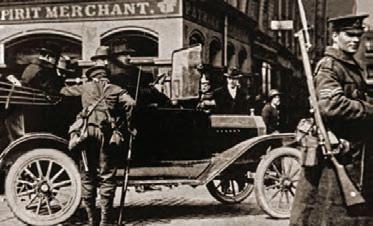
2 minute read
Restricting motoring in Ireland 1918–21 — James Scannell
WICKLOW COUNTY – James Scannell
Restricting motoring in Ireland 1918–21
Advertisement
Morris Cars on sale in the 1920s Photo: By kind permission of the National Library of Ireland
Permits required
In October 1918, as political unrest swept the country, the Dublin Castle authorities introduced ‘Defence of the Realm Regulation 9AA’, under which owners of motorcycles in Ireland, other than serving members of H.M. Forces or the Royal Irish Constabulary or the Dublin Metropolitan Police, were required to hold a permit from the competent naval or military authority, or from the chief police officer of the district in which the motorcyclist resided, and had to produce this when stopped. In November 1919, this permit requirement was extended to owners of motor cars. Wicklow Council strongly opposed the new restrictions, and in January 1920, protest pickets resulted in long delays on the roads.
Military courts and further restrictions
In August 1920, following the collapse of law and order in Ireland, the British government enacted the ‘Restoration of Order in Ireland Act, 1920’, which

British Army search vehicle, Dublin, Feb 1920. Alamy Stock Photo extended the scope of military courts-martial to try citizens and replaced coroner inquests with military courts of inquiry that were frequently held behind closed doors with relatives of the deceased, the public and press excluded. The regulations introduced under this legislation continued the prohibitions and restrictions of having, keeping, or using a motor-cycle or motor car without a permit.
In December 1920, further restrictions were introduced on where a vehicle (motorcycle or motor car) could be kept, the time of the day that the vehicle could be used, and the distance that could be travelled: Vehicles could only be used between 6 a.m. and 8 p.m. and could not travel more than 20 miles from where the permit holder resided.
Exemptions
Special permits exempting holders from the curfew were granted to religious ministers of all denominations, medical practitioners, veterinary surgeons, and nurses. In February 1921, even the riding of a bicycle was prohibited; however, in July 1921, in the wake of the Truce, the restrictions limiting the hours and distance that a person owning a motor vehicle could travel were suspended.
Sources
Connell, Joseph E. A., Jr., ‘100 Years Ago – Restoration of Order in Ireland Act’ in History Ireland, July/August 2020, Vol. 28, No. 4. O’Riordan, Dermot, ‘Driving and Cycling Regulations During the War of Independence’ in Dún Laoghaire Borough Historical Journal, 2014. Sheehan, William, Fighting for Dublin: The British Battle for Dublin 1919–1921 (Cork, 2007). Yeates, Pádraig, A City in Turmoil: Dublin 1919–1921 (Dublin, 2015).










